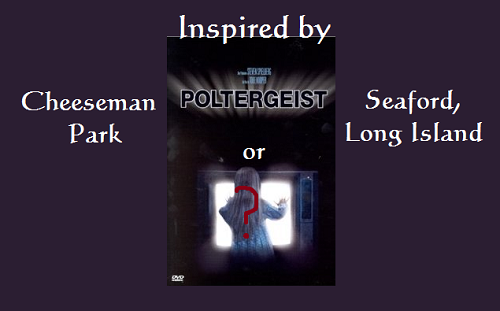
Over the weekend I watched a show called “Real Fear.” Or part of the show I should say. I didn’t see the whole thing, but I caught a good chunk of it. The show’s whole title is “Real Fear: The Truth Behind Movies.” This episode was the truth behind Steven Spielberg’s Poltergeist.
POPPER THE POLTERGEIST
In 1958, in Seaford, New York, the Hermann family suddenly found their home under siege by a ghost they named “Popper.” The activity Popper was said to initiate had many witnesses, including a Newsday reporter. (Who I want to say during the Real Fear episode either said or was quoted as saying he was a total non-believer in ghosts and the paranormal until he witnessed what was happening in the Hermann house. Someone said it at any rate. Not sure if it was him, but after witnessing the events in this house they became a believer in the supernatural.)
The show said it was the Hermann House Popper the Poltergeist case that Steve Spielberg based Poltergeist on. They pointed out the similarities between the 1958 event and the movie.
Such as the family being haunted was a suburban one, it was thought their house was built on an America Indian burial ground (or very near one), the furniture rearranged itself (think of the scene in the movie where the chairs in the kitchen stacked themselves), lights turned off and on, and even paranormal investigators were called in to investigate.
Of course, most of the movie was based on imagination, but perhaps the nugget came from a real poltergeist case?
BUT WHAT ABOUT CHEESEMAN PARK?
I had never heard Popper the Poltergeist was the inspiration for the movie. I had heard the macabre history of Denver, Colorado’s Cheeseman Park inspired it.
Have I been mistaken all these years thinking (and repeating) that Cheeseman inspired Spielberg’s screenplay?
If so, I’m certainly not alone. This site, Making Of…Poltergeist Rehind the Scenes, also mentions Cheeseman Park as providing inspiration. And if you Google “Cheeseman Park Poltergeist” you’ll get links to a whole bunch of other articles citing Denver’s park served as inspiration.
If you Google “Long Island Poltergeist” or “Seaford Long Island Poltergeist” you’ll definitely find links to stories about Popper the poltergeist, but the only one that references any connection between it and Poltergeist the movie is “Real Fear’s” site and a Huffington Post article about “Real Fear.”
ANOTHER “POLTERGEIST” CLAIM TO FAME
However, another article I came across says the Rothschild house in Wisconsin, who some thought may have also been inspiration for Poltergeist, was not. Again, there were some similarities between the haunting that happened to a family in that town in 1972 and the movie. However, people mistakenly drew the conclusion that’s what had inspired Spielberg’s muse.
Could the same have happened with Cheeseman Park?
WHO DOESN’T HAVE THEIR FACTS STRAIGHT?
I haven’t been able to find a definitive answer either way.
Which caused my heart some dismay. I hope this isn’t an example of poor fact checking on “Real Fear” and Huffington Post‘s part. (Like how “Fact or Faked” and Time failed to fact check that there is no Department of anything’s haunted places list before citing it as a source.)
Mr. Spielberg, if you ever happen to read this, is there any way you could set the record straight?
ANOTHER “POLTERGEIST” CONTROVERSY
I didn’t know this, but while researching Poltergeist for this post I discovered some people felt Spielberg, not Tobe Hooper, actually directed the movie in addition to writing and producing it. Spielberg couldn’t direct it due to contractual reasons with E.T.
The confusion came from a couple of places apparently. Like how his name was more prominently placed as being associated with it for advertising purposes. Also, some reporters came to do a story on the movie on a day Spielberg happened to be on set shooting secondary shots.
Spielberg was definitely involved in the production, but technically Tobe Hooper directed Poltergeist.
Courtney Mroch is a globe-trotting restless spirit who’s both possessed by wanderlust and the spirit of adventure, and obsessed with true crime, horror, the paranormal, and weird days. Perhaps it has something to do with her genes? She is related to occult royalty, after all. Marie Laveau, the famous Voodoo practitioner of New Orleans, is one of her ancestors. (Yes, really! As explained here.) That could also explain her infatuation with skeletons.
Speaking of mystical, to learn how Courtney channeled her battle with cancer to conjure up this site, check out HJ’s Origin Story.

Poltergeist was also based, in part, on the Black Hope Cemetery case in Texas where an entire sub-division was built on top of an old black cemetery. Instead of relocating the bodies, the people in charge of building this street decided to take down the markers and leave the bodies. Nearly everyone who owned one of the new houses reported haunting experiences and many left their homes at a great financial loss. A movie was made in the early 90s about the incident called Grave Secrets: The Legacy of Hilltop Drive and starred Patty Duke and David Soul. A book was also written called The Black Hope Horror by two former residents.
Oh wow. Very interesting, Mike. I’ve heard of the Black Hope Horror but did not know what it was about. Thanks for leaving this comment!